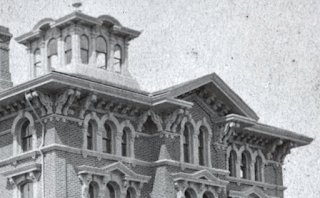 |
| The C. A. Newcomb House, Detroit, MI. 1876 Source: Scott Weir |
Built in 1876 for a major Detroit retailer and
opera house owner, the Cyrenus Adalbert Newcomb house (gotta give the Victorians props for their unique names), is an exceptionally high style
symmetrical plan villa with a protruding central bay with an open pediment. The house is a play on variations, with brick and stone and arches in various combinations all vying to be different and grab attention. On the first floor, we have two bay windows, with columned pilasters. Interestingly, the cornice of this window has an architrave molding that forms a gable over each window, clashing with the roundness of the window arch but reflecting the angularity of the pointed keystone. The first floor porches are characterized by fanciful, foliate and decidedly unclassical capitals supporting shallow basket handle arches. Heavy balustrades top each element. On the second floor, we have triple arched palladian windows (the arch variation is very slight) on the sides, and a double tombstone window in the center; all are joined into a single unit with thick stone surrounds and a bracketed, pedimented cornice (open on the sides, closed in the center). The third story has a stringcourse that separates it visually, a very Sloan touch, with a repetition of the window patterns between flanking and central bays, though with simpler surrounds and no cornice. These interrupt the architrave molding which supports paired
double s scroll brackets that appear very elaborate with bulls eyes and incised designs, and a run of smaller rotated s scroll brackets, resting on yet another molding! To top it all, and to contrast with the angularity of the gables, the cupola is classically designed with Tuscan pilasters, a further triple arched palladian, and an engaged segmental arch in the cornice. The only variation on this scheme are the segmental arched windows found on the simpler side façade. The whole effect is one of extreme richness and complexity, kind of like a piece of renaissance revival furniture transformed into a house. Nearly every trick in the architectural book to jazz up and make complex the façade is used. Surely nothing could be more appropriate for the man responsible for Detroit's over the top opera house downtown.



No comments:
Post a Comment